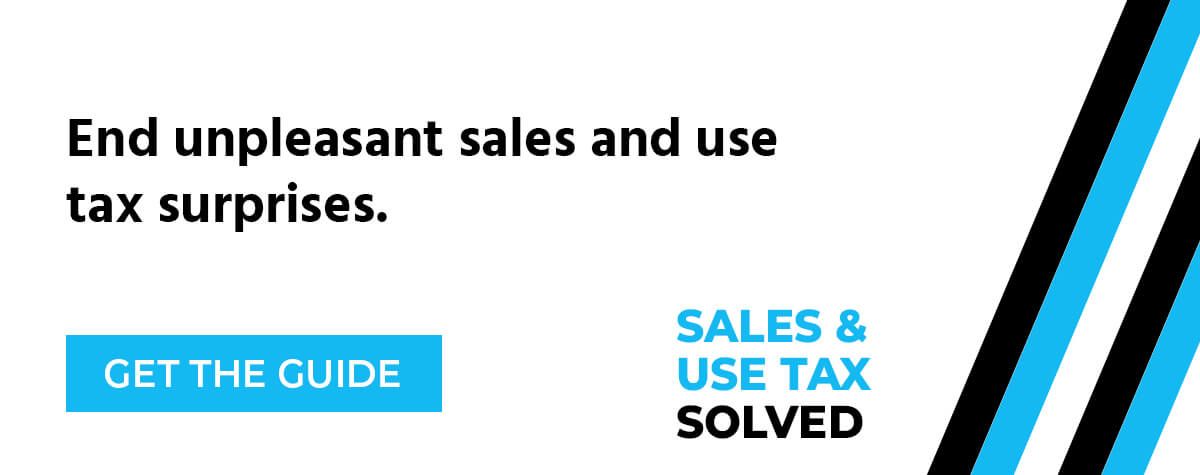This blog was last updated on September 2, 2021
@media (min-width: 1060px) { .div-ad { width: 60%; float: right; padding: 25px; margin-bottom: 25px; margin-left: 25px; margin-right: -100px; box-shadow: 3px 3px 3px #ebedef; } } .div-ad-link { color: #015FFF; text-decoration: underline !important; } @media (min-width: 1060px) { .pja-image { width: 60%; float: left; padding-left: 15px; margin-right: 25px; margin-left: -100px; } } @media (max-width: 1060px) { .pja-image { display: block; margin-left: auto; margin-right: auto; } }
Picture this scenario: You input your sales and use tax data into your automated tax management tool and wait for your filings to be ready. A few days later, you get your determinations and have 24 hours to sign off.
You try to do quality control, but the forms don’t provide visibility into what data went into the determinations, so you waste time and suffer from stress before finally giving up and approving the return so it won’t be late. A few weeks later, you find yourself filing corrections after you discover errors in the certifications.
In a world where there are cars that can drive you to work without you touching the wheel, should the basic functions you’re responsible for once you arrive there really be this difficult to get right?
The pain of doing taxes manually
You might think the solution to the scenario above is to reconcile your sales and use tax yourself. You’ll have visibility into the numbers then, of course, but choosing this path presents other, bigger problems.
Managing sales and use tax filings is labor intensive, so there’s no question you’ll spend hours on the process. Your time — and tranquility — will be swallowed up at the start of every month as you work to close the books accurately.
And while sales and use tax management is already a daunting prospect, it’s quite possible it will get even harder. Some states — such as Massachusetts, Connecticut, Nebraska, and New York — are proposing to turn up the intensity on sales tax filing by demanding tax revenue in real time based on actual collections. While such rules haven’t gone into effect yet, many companies’ accounting departments would crumble under the weight of them.
“If you’re doing it manually, that’s a lot of work to make sure that information is consolidated correctly and then put on the correct return,” says Tim Roden, solution principal for sales and use tax at Sovos. “There are all sorts of spreadsheets involved. And if you’re using a software provider, it’s difficult to make sure that all the data from all the different channels is normalized and put on the returns correctly.”
The sustainability of this in-house tax-management system is tenuous. Automation is an obvious solution to the complexities of sales and use tax filings, especially when you’re in growth mode. However, automation isn’t always the silver bullet you hope it will be.
The pain of unsatisfactory sales and use tax automation
Not all automated sales and use tax solutions are created equal. Here are some of the common problems those using these tools run into.
- Problems with accuracy: It seems a pretty basic requirement for tax solutions to employ the correct forms and the most up-to-date data about tax regulations. But you’ll find accuracy issues in a surprising number of leading sales and use tax automation solutions.
- Increased risk: Some tax tools fail to maintain current and accurate nexus configurations, putting you at risk of running afoul of compliance laws. These systems often won’t proactively highlight missing data or alert you to additional or changed obligations.
- Lack of transparency: It can be difficult to reconcile discrepancies without sufficient insight into what data and calculations went into each determination. Disappointing SUT solutions don’t provide background on how these numbers were derived, making it difficult to confirm accuracy and make changes where necessary.
- Frustrations with oversight: Short turnaround times and lack of transparency may prevent you from properly vetting your returns, resulting in errors slipping through and the need for corrections at a later date.
- Poor customer service and cost changes: Some services prioritize the highest-paying clients, so that customer service for others suffers. You may have to pay more for robust support. And subscription costs may also shoot up without notice. If you are still spending a lot of time greasing the process and checking for accuracy, the ROI might not be all you’d hoped.
More in the “Sales and Use Tax Solved” series:
ARTICLE: Growth is great – but is your approach to tax keeping up?
ARTICLE: It’s 2021. No more unpleasant sales and use tax surprises
What does an ideal tax solution look like?
A tax solution that is the equivalent of a self-driving car should provide you accuracy, transparency, traceability, and consistency. You should be in the driver’s seat.
You should be able to use the system without aggravation. You should be able to see how the system derived each of the numbers in the filing so you can trace them all back to your own books. You should be able to seek clarification and make corrections easily.
That kind of transparency will allow you to easily answer any questions that arise in approving an accurate return. You’ll already be confident in the numbers when you get your returns for sign-off.
“With the Sovos solution, you can see each individual transaction that makes up the return and the tax obligation associated with each individual transaction,” says Roden. “It’s really transparent. You can know for sure that your return is correct.”
This type of solution will free you up to address other priorities. That reallocation of your time will not only support business strength and growth, but will also make you and your accounting colleagues much happier on the job. Sovos automates the labor-intensive process of sales and use tax filings to provide that ideal, self-driving tax-prep solution.
Download our guide to learn more about what sales and use tax can feel like without the surprises.
